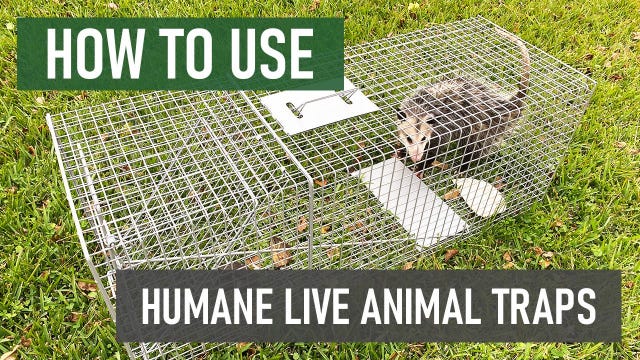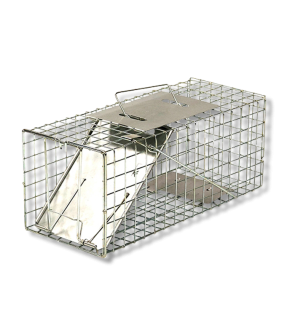Gain access to personalized product screening, the best pricing, rewards, and more!
Most Effective Products
How to Catch a Chipmunk with a Live Trap
Chubby-cheeked chipmunks are adorable, but don't let that face fool you - they can cause severe damage to your home. These small animals create burrows that can ruin your lawn and foundation. If they can access it through an opening, chipmunks can also find shelter in your attic or shed. One method of removing a chipmunk from your property is using a live trap to catch and release the animal. Live trapping is a safe and effective way to keep animals away from your home.
If you want to catch a chipmunk with a live trap, read this guide for instructions and product recommendations.
Identification
Before using a live trap, you must ensure the wild animal you are dealing with is a chipmunk. This will ensure that you are using the correct bait and strategies.

Chipmunks are generally 2 to 6 inches long with a 3-inch tail. They normally weigh less than one pound and mainly feed on seeds, nuts, and fruit. Their color can vary between brown, yellow, and gray. They also have black and white stripes down their backs.
Use the image and description above to confirm that you are dealing with a chipmunk on your property.
Inspection
Once you've confirmed that your pest animal is a chipmunk, it is helpful to recognize the areas where it is most active. This is where you will place your live trap.
Where to Inspect
You want to pick areas with high activity from chipmunks. These animals will likely be in areas with trees and shrubbery, searching your property for shelter.
What to Look For
Look for disturbed areas in your yard or garden. Chipmunks are burrowers. They dig holes for shelter, rest, and nesting. Chipmunk tracks may also be visible. These tracks will look like tiny hands with four toes on the front and five toes on the hind feet.
Treatment
Now that you've identified your pest animal as a chipmunk and noted areas where it is most active, you can use your live trap. Wear gloves when handling the trap to prevent leaving your scent. If a chipmunk picks up a human scent on the trap, it will avoid it, making it ineffective.
Step 1: Remove Food Sources

You want the chipmunk to enter the live trap with the help of bait. Because of this, competing food sources need to be removed. Keep your trash sealed in trash bags and stored in trash bins with a lid to keep it closed. Any pet food or water bowls should be placed inside as soon as possible.
Step 2: Place the Trap

By now, you should have taken note of areas with high chipmunk activity. These areas are where you will put your trap. Be sure to place your trap on an even surface. A chipmunk might push or knock over the trap to reach the bait inside. Place a brick or weight on top of the trap to avoid this.
Step 3: Bait and Set the Trap

Using the proper bait will increase your chances of catching a chipmunk. These animals prefer nuts, but it is best to use peanut butter so chipmunks cannot take the bait and run away. The bait should be placed near the back of the trap. This ensures the chipmunk must step on the trigger plate to reach the food.
You will then set your trap by pushing on the door lock and lifting the door plate. Keep the door plate lifted while pulling the trigger arm forward to set it. You will know it is set when the trigger arm's hook catches the door.
Step 4: Monitor the Trap
You will need to check the traps twice a day, preferably once in the morning and once in the evening. This is when you will refill bait if needed. Checking the trap frequently may dissuade chipmunks from approaching the trap. Do not keep an animal trapped in the cage for 24 hours.
Step 5: Relocate the Chipmunk
Any non-target animals should be released immediately. Once you have captured a chipmunk in your live trap, check with your local authorities to ensure you correctly relocate the animal. Approach the trap slowly and use a gentle voice. Place a towel over the cage to avoid frightening the chipmunk. Once you have relocated far enough, carefully open the trap and release the animal. You can read more about releasing an animal from a live trap here.
Prevention
After using your live trap, you want to ensure that wild animals do not invade your property again. You can take some preventative measures to keep your area chipmunk-free.
Sanitation
Remove all clutter and debris from your property since chipmunks may be drawn to nest and burrow in these areas. Keep trash in a closed container. Any potential food or water sources, especially pet food, should be properly sealed in a container and stored indoors. Regularly check the property for spots that retain water.
Exclusion
To prevent chipmunks from entering your home, check the foundation for cracks and openings. These can be sealed with Stuf-Fit Copper Mesh and caulk. Stuf-Fit is a breathable material that many animals cannot chew through. It will not rust and can be stuffed into cracks and crevices before sealing with caulk. Repair any voids or openings around the home or structure.
Key Takeaways
- Chipmunks are small creatures with a great sense of smell. They are most likely invading your area looking for food and shelter. These tiny creatures can cause severe damage to your yard and foundation.
- Bait the live trap with peanut butter, placing it behind the trigger plate.
- Check the trap once in the morning and once in the evening. Once a chipmunk is caught, check with your local authorities to ensure you safely and correctly release it.
- Prevent chipmunks from entering your property again by removing any potential food sources and trash and sealing any cracks and crevices with Stuf-Fit Copper Mesh and caulk.











